Uniform Spheres of α-NaYF4:RE3+ (RE=Eu, Tb, Ce, Er, and Tm): Template-Free Synthesis, Multi-Color Photoluminescence, and Their Application in Cellular Imaging
Abstract
:1. Introduction
2. Experimental
2.1. Synthesis
2.2. Surface Functionalization
2.3. Characterization Techniques
2.4. Cells Imaging
3. Results and Discussion
4. Conclusions
Supplementary Materials
Author Contributions
Funding
Acknowledgments
Conflicts of Interest
References
- Blasse, G.; Grabmair, B.C. Luminescent Materials; Springer: Berlin/Heidelberg, Germany, 1994. [Google Scholar]
- Liu, Y.S.; Tu, D.T.; Zhu, H.M.; Chen, X.Y. Lanthanide-doped luminescent nanoprobes: Controlled synthesis, optical spectroscopy, and bio applications. Chem. Soc. Rev. 2013, 42, 6924–6958. [Google Scholar] [CrossRef]
- Wang, F.; Han, Y.; Lim, C.S.; Lu, Y.; Wang, J.; Xu, J.; Chen, H.; Zhang, C.; Hong, M.; Liu, X. Simultaneous phase and size control of upconversion nanocrystals through lanthanide doping. Nature 2010, 463, 1061–1065. [Google Scholar] [CrossRef]
- Li, C.X.; Lin, J. Rare earth fluoride nano-/microcrystals: Synthesis, surface modification and application. J. Mater. Chem. 2010, 20, 6831–6847. [Google Scholar] [CrossRef]
- Yang, B.; Zeng, H.D.; Zhang, Y.Y.; Deng, Y.F.; Guo, Y.Y.; Chen, J.D.; Chen, G.R. Enhanced NIR down-conversion of Yb3+ in fluorosilicate glass-ceramics co-doped with Bi ions. Opt. Mater. 2018, 84, 189–194. [Google Scholar] [CrossRef]
- Dan, H.K.; Qiu, J.B.; Zhou, D.C.; Wang, R.F. Broadband near-infrared emission and energy transfer in Nd-Bi co-doped transparent silicate glass-ceramics for optical amplifiers. Opt. Mater. 2018, 85, 517–522. [Google Scholar] [CrossRef]
- Li, X.Y.; Liu, X.W.; Chevrier, D.M.; Qin, X.; Xie, X.J.; Song, S.Y.; Zhang, H.J.; Zhang, P.; Liu, X.G. Energy migration upconversion in manganese (II)-doped nanoparticles. Ange. Chem. Int. Ed. 2015, 54, 13312–13317. [Google Scholar] [CrossRef]
- Zhu, Q.; Song, C.Y.; Li, X.D.; Sun, X.D.; Li, J.-G. Up-conversion monodispersed spheres of NaYF4:Yb3+/Er3+: Green and red emission tailoring mediated by heating temperature, and greatly enhanced luminescence by Mn2+ doping. Dalton Trans. 2018, 47, 8646–8655. [Google Scholar] [CrossRef]
- Xu, X.; Wang, Z.; Lei, P.P.; Yu, Y.N.; Yao, S.; Song, S.Y.; Liu, X.L.; Su, Y.; Dong, L.L.; Feng, J.; et al. α-NaYb(Mn)F4:Er3+/Tm3+@NaYF4 UCNPs as “band-shape” luminescent nanothermometers over a wide temperature range. ACS Appl. Mater. Interfaces 2015, 7, 20813–20819. [Google Scholar] [CrossRef]
- Yang, D.M.; Kang, X.J.; Ma, P.A.; Dai, Y.L.; Hou, Z.Y.; Cheng, Z.Y.; Li, C.X.; Lin, J. Hollow structured upconversion luminescent NaYF4:Yb3+, Er3+nanospheres for cell imaging and targeted anti-cancer drug delivery. Biomaterials 2013, 34, 1601–1612. [Google Scholar] [CrossRef]
- Luo, R.; Li, T.; Chen, Y.; Ning, Z.; Zhao, Y.; Liu, M.; Lai, X.; Zhong, C.; Wang, C.; Bi, J.; et al. Na(1-x)Lix(Gd0.39Y0.39Yb0.2Er0.02)F4 (0≤ x≤1) solid solution microcrystals: Li/Na ratio-induced transition of crystalline phase and morphology and their enhanced upconversion emission. Cryst. Growth Des. 2018, 18, 6581–6590. [Google Scholar] [CrossRef]
- Leménager, G.; Thiriet, M.; Pourcin, F.; Lahlil, K.; Valdivia-Valero, F.; Colas des Francs, G.; Gacoin, T.; Fick, J. Size-dependent trapping behavior and optical emission study of NaYF4 nanorods in optical fiber tip tweezers. Opt. Express 2018, 26, 32156–32167. [Google Scholar] [CrossRef] [PubMed]
- Zhang, Y.Y.; Wang, Y.; Deng, J.Q.; Wang, J.; Ni, S.C. Highly efficient Yb3+/Tm3+ co-doped NaYF4 nanotubes: Synthesis and intense ultraviolet to infrared up-conversion luminescence. Opt. Commun. 2014, 312, 43–46. [Google Scholar] [CrossRef]
- Zhu, Q.; Li, J.-G.; Zhi, C.; Li, X.D.; Sun, X.D.; Sakka, Y.; Golberg, D.; Bando, Y. Layered rare-earth hydroxides (LRHs) of (Y1-xEux)2(OH)5NO3·nH2O (x=0-1): Structural variations by Eu3+ doping, phase conversion to oxides, and the correlation of photoluminescence behaviors. Chem. Mater. 2010, 22, 4204–4213. [Google Scholar] [CrossRef]
- Judd, B.R. Optical Absorption Intensities of Rare-Earth Ions. Phys. Rev. 1962, 127, 750–761. [Google Scholar] [CrossRef]
- Ofelt, G.S. Intensities of Crystal Spectra of Rare-Earth Ions. J. Chem. Phys. 1962, 37, 511–520. [Google Scholar] [CrossRef]
- Zhang, D.P.; Yue, Z.; Liu, Z.Y. Dual-mode luminescent core-shell nanoarchitectures for highly sensitive optical nanothermometry. J. Alloys Compd. 2019, 787, 585–593. [Google Scholar] [CrossRef]
- Zhu, Q.; Xu, Z.X.; Wang, Z.H.; Wang, X.J.; Li, X.D.; Sun, X.D.; Li, J.-G. Multi-color emission in monodispersed spheres of tetragonal yttrium phosphate: Microwave-assisted fast synthesis, formation mechanism, temperature-dependent luminescence, and application in anti-fake label. CrystEngComm 2018, 20, 3187–3201. [Google Scholar] [CrossRef]
- Wang, D.; Zhang, P.; Ma, Q.; Zhang, J.; Wang, Y.H. Synthesis, optical properties and application of Y7O6F9:Er3+ for sensing the chip temperature of a light emitting diode. J. Mater. Chem. C 2018, 6, 13352–13358. [Google Scholar] [CrossRef]
- Zhang, J.J.; Qiao, B.; Liang, Z.Q.; Zuo, P.F.; Wu, Q.X.; Xu, Z.; Piao, L.Y.; Zhao, S.L. Near-infrared light-induced photocatalysis of NaYF4:Yb,Tm@Cu2O core-shell nanocomposites. Opt. Mater. 2018, 84, 89–93. [Google Scholar] [CrossRef]
- Nakamoto, K. Infrared Spectra of Inorganic & Coordination Compounds; John Wiley & Sons: New York, NY, USA, 1963. [Google Scholar]
- Gadsden, J.A. Infrared Spectra of Minerals and Related Inorganic Compounds; Butterworth: Newton, MA, USA, 1975. [Google Scholar]
- Abdukayum, A.; Chen, J.-T.; Zhao, Q.; Yan, X.-P. Functional near infrared-emitting Cr3+/Pr3+ co-doped zinc gallogermanate persistent luminescent nanoparticles with superlong afterglow for in vivo targeted bioimaging. J. Am. Chem. Soc. 2013, 135, 14125–14133. [Google Scholar] [CrossRef]
- Zhu, Q.; Xu, Z.X.; Li, X.D.; Li, J.-G. Tetragonal (Y,Ln)PO4·nH2O (Ln=Tb/Eu) colloidal spheres for color tunable photoluminescence and the effects of hydration. Opt. Mater. 2019, 92, 71–80. [Google Scholar] [CrossRef]
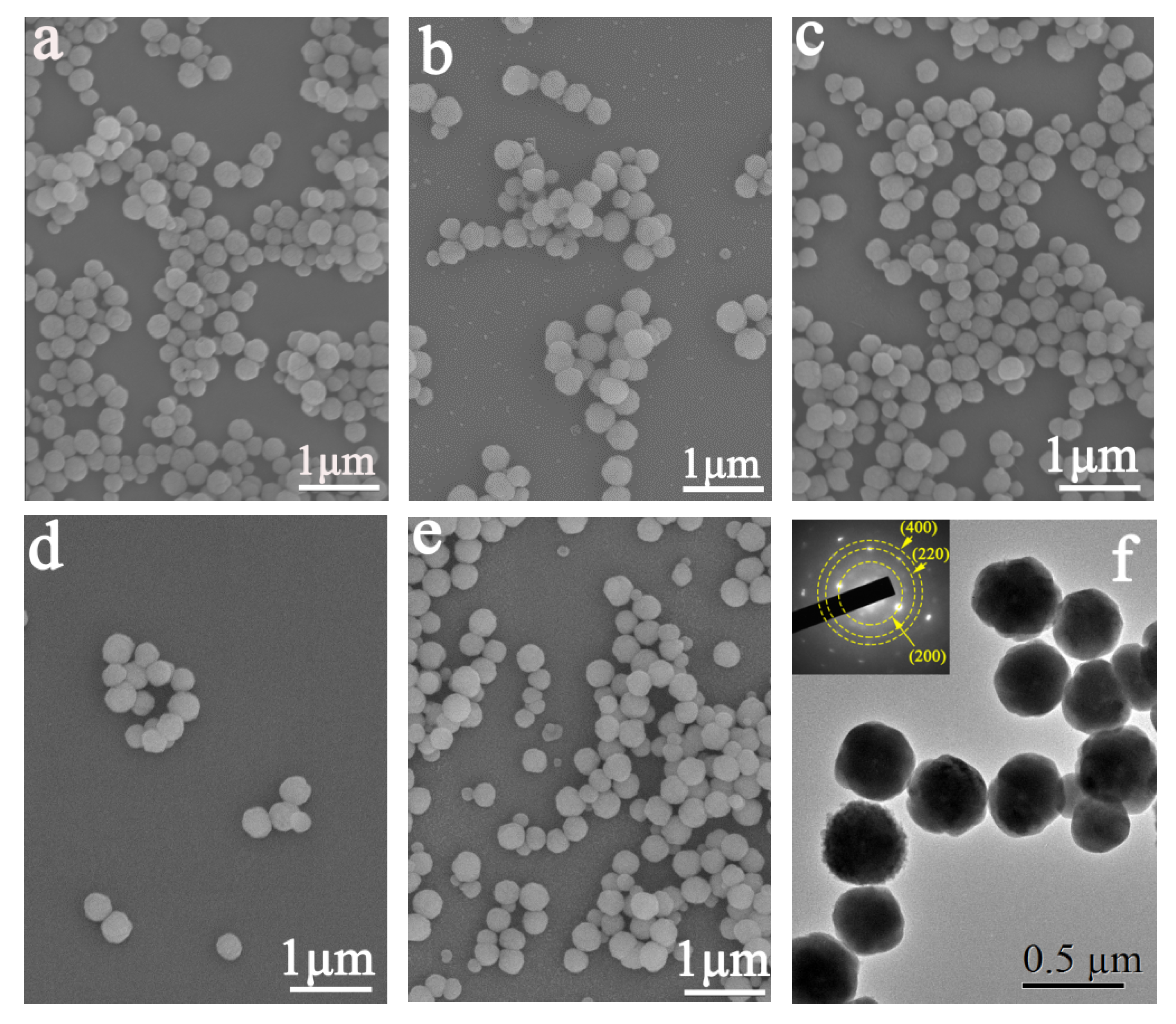
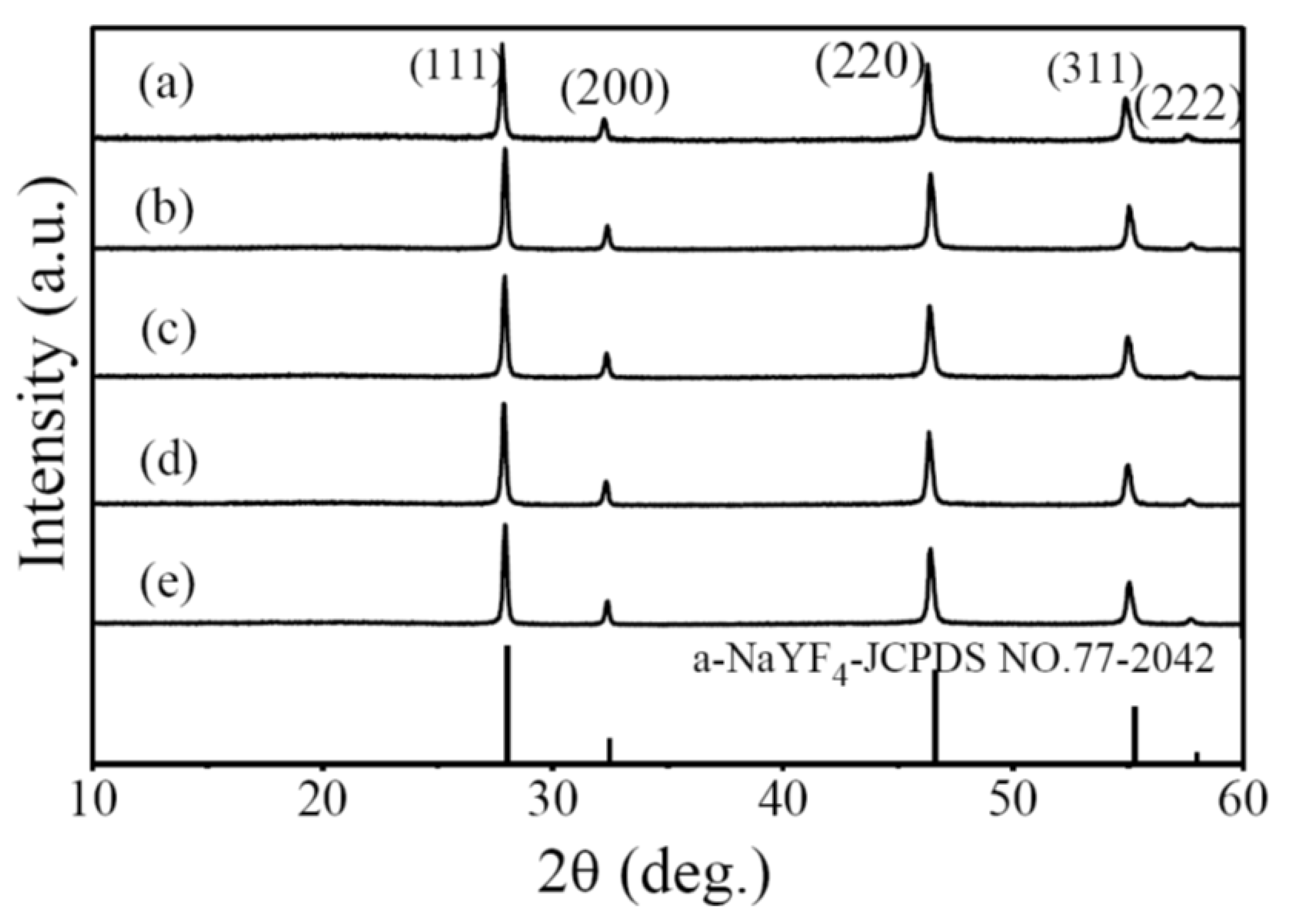
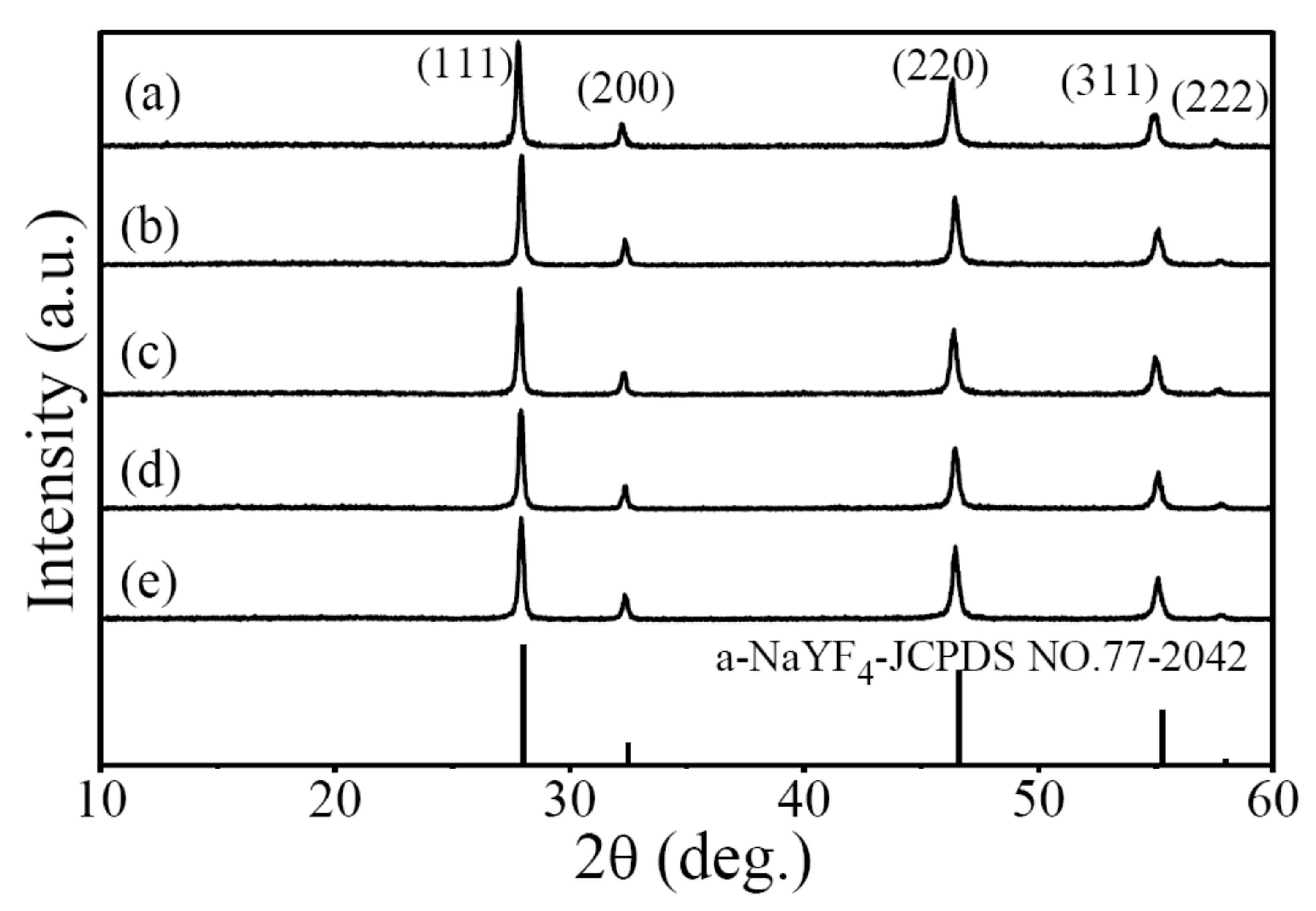
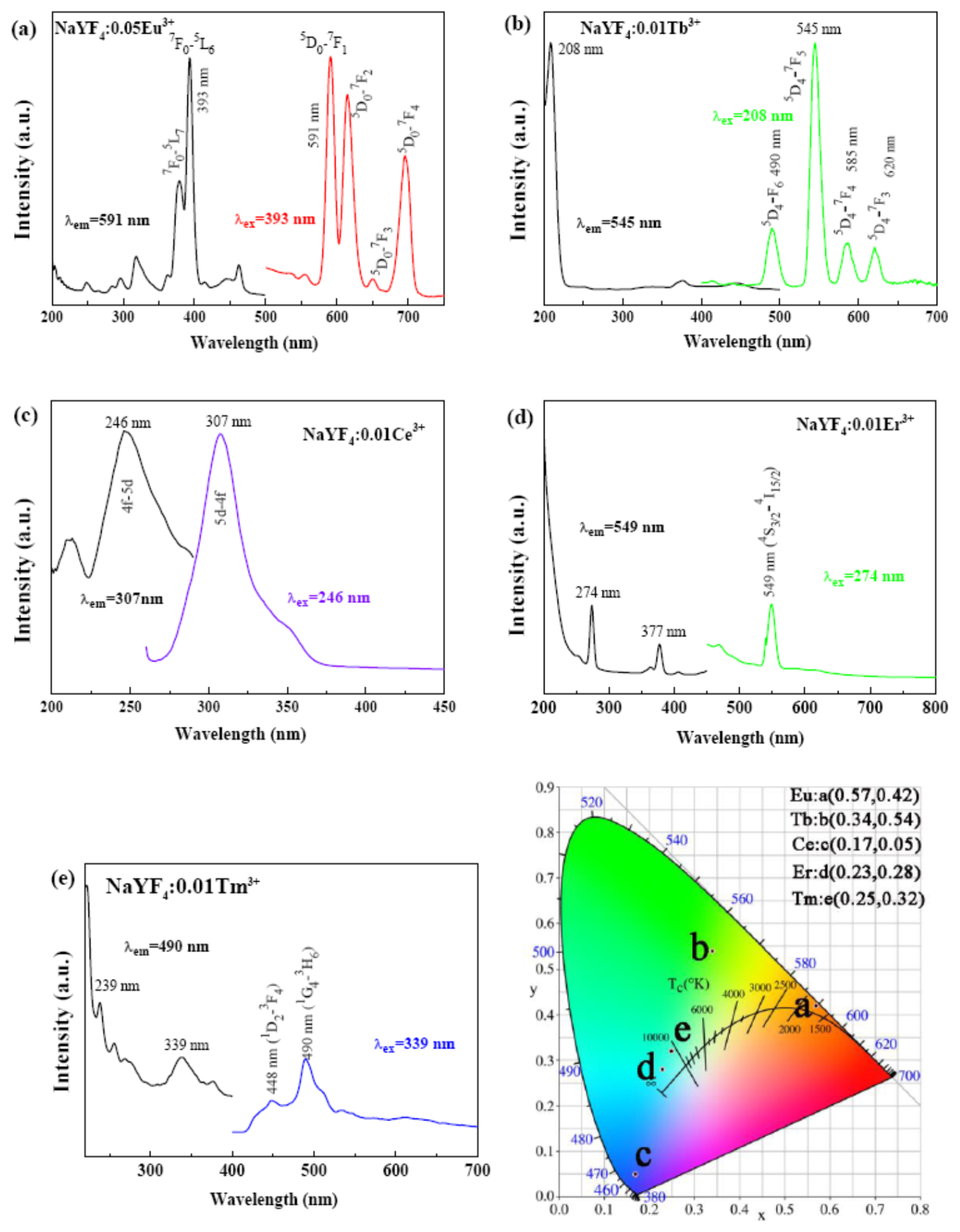
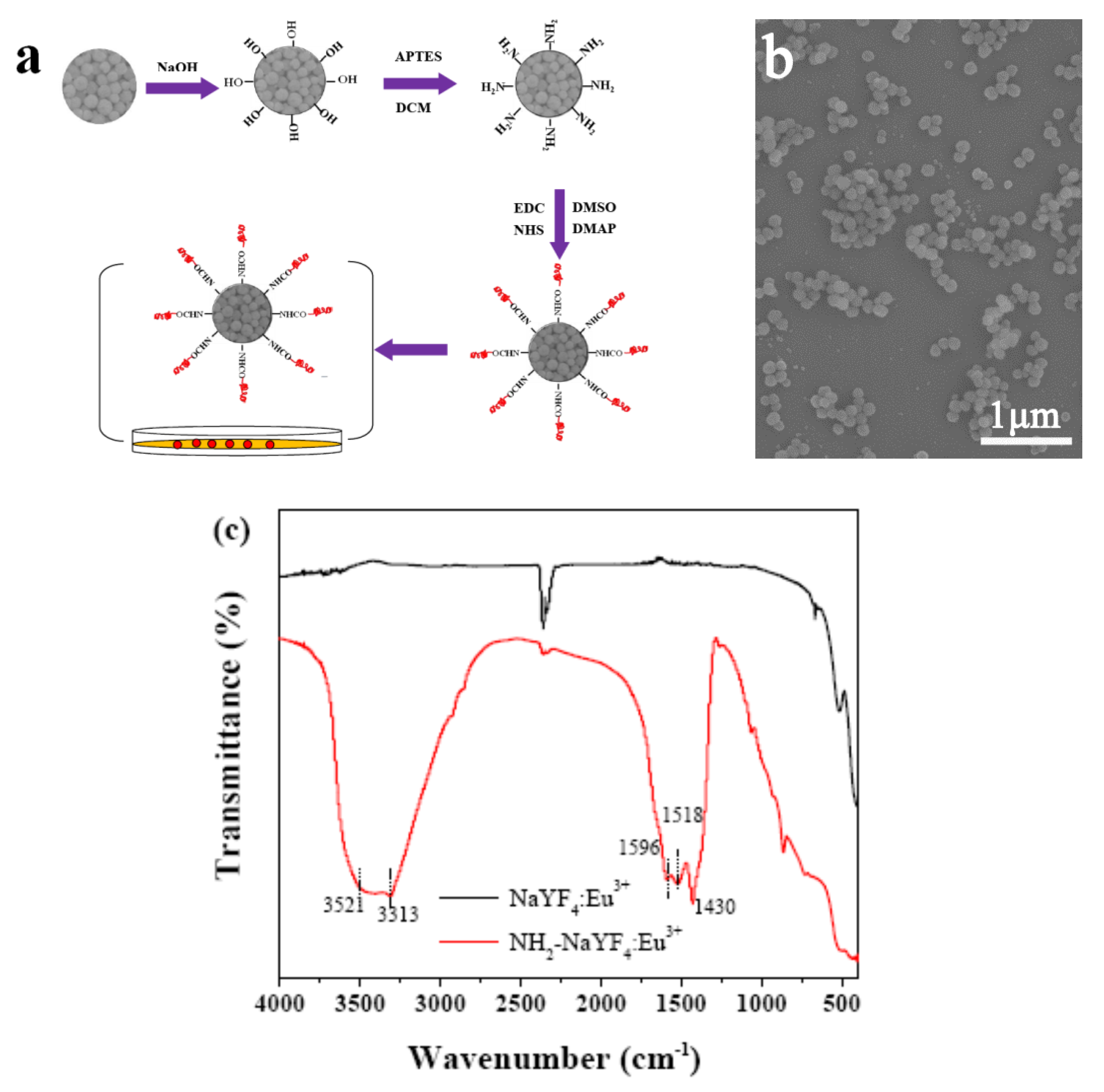
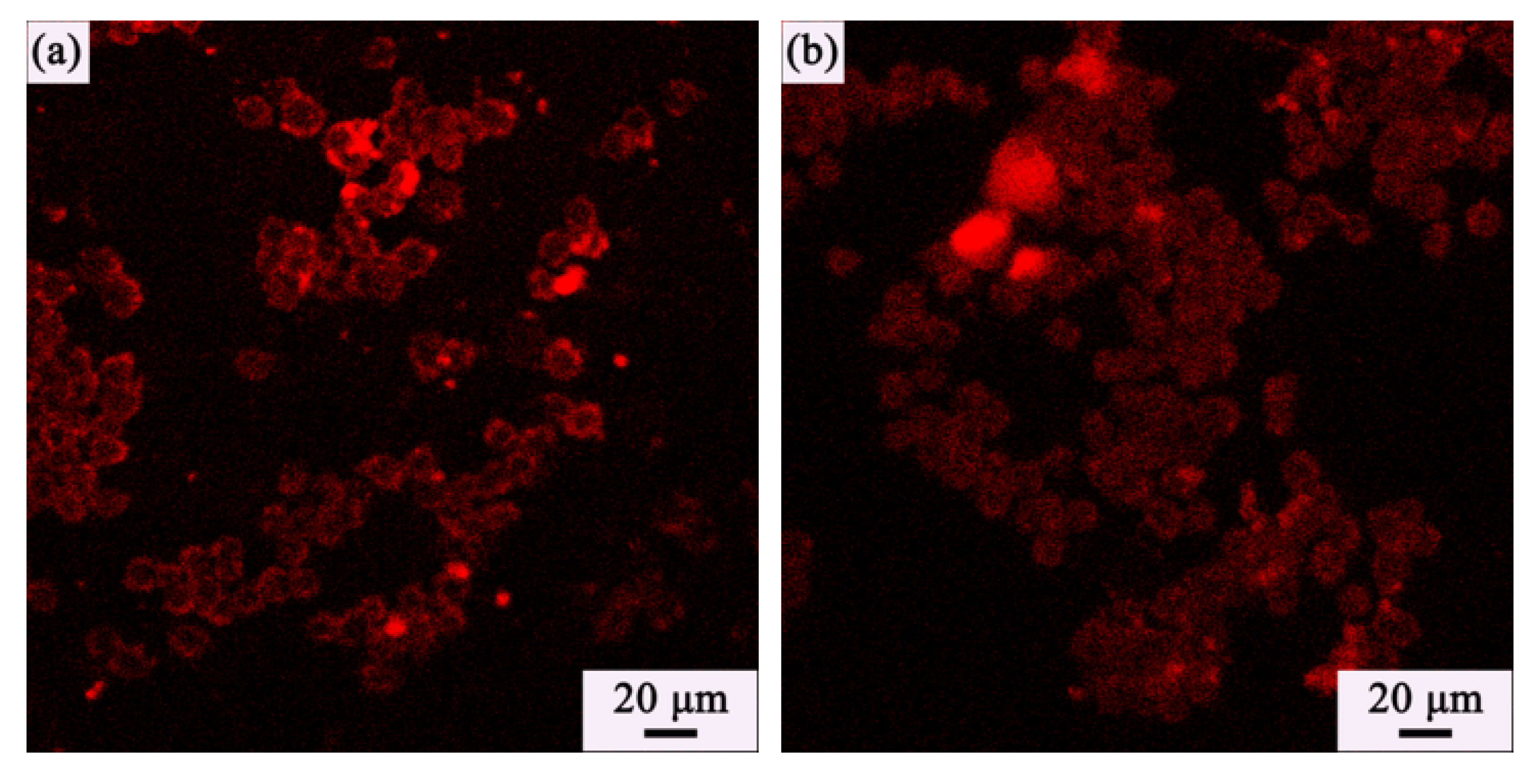
© 2020 by the authors. Licensee MDPI, Basel, Switzerland. This article is an open access article distributed under the terms and conditions of the Creative Commons Attribution (CC BY) license (http://creativecommons.org/licenses/by/4.0/).
Share and Cite
Fan, X.; Gu, L.; Hu, Y.; Zhu, Q. Uniform Spheres of α-NaYF4:RE3+ (RE=Eu, Tb, Ce, Er, and Tm): Template-Free Synthesis, Multi-Color Photoluminescence, and Their Application in Cellular Imaging. Crystals 2020, 10, 119. https://doi.org/10.3390/cryst10020119
Fan X, Gu L, Hu Y, Zhu Q. Uniform Spheres of α-NaYF4:RE3+ (RE=Eu, Tb, Ce, Er, and Tm): Template-Free Synthesis, Multi-Color Photoluminescence, and Their Application in Cellular Imaging. Crystals. 2020; 10(2):119. https://doi.org/10.3390/cryst10020119
Chicago/Turabian StyleFan, Xiaofeng, Laiqin Gu, Yiling Hu, and Qi Zhu. 2020. "Uniform Spheres of α-NaYF4:RE3+ (RE=Eu, Tb, Ce, Er, and Tm): Template-Free Synthesis, Multi-Color Photoluminescence, and Their Application in Cellular Imaging" Crystals 10, no. 2: 119. https://doi.org/10.3390/cryst10020119
APA StyleFan, X., Gu, L., Hu, Y., & Zhu, Q. (2020). Uniform Spheres of α-NaYF4:RE3+ (RE=Eu, Tb, Ce, Er, and Tm): Template-Free Synthesis, Multi-Color Photoluminescence, and Their Application in Cellular Imaging. Crystals, 10(2), 119. https://doi.org/10.3390/cryst10020119




